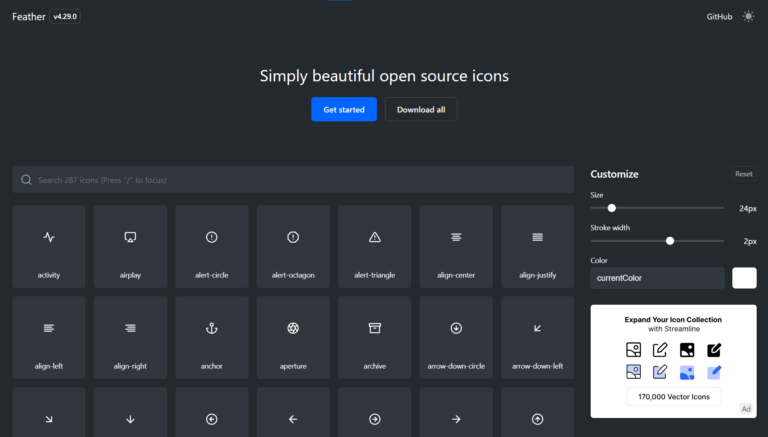Top Best FREE "Font Awesome" Alternatives in 2025
In the ever-evolving landscape of web design, the tools and resources developers rely on continue to transform. For over a decade, Font Awesome has been the go-to icon library for countless websites and applications. However, as design trends shift and development practices advance, a new wave of icon solutions has emerged, offering compelling alternatives to this long-standing industry standard.
The Changing Face of Web Icons
"Icon libraries have become central to the modern web experience," explains Sasha Rodriguez, UX Director at DesignForward. "What we're seeing in 2025 is a move toward more customizable, lightweight options that integrate seamlessly with today's development frameworks."
This shift comes as designers increasingly prioritize loading speeds and unique brand expressions, moving away from the ubiquitous look that once dominated the web.
Leading Contenders in the Icon Space
Lineicons: The New Heavyweight
Emerging as perhaps the most comprehensive alternative, Lineicons has established itself as a powerhouse in the icon market. With an impressive collection exceeding 30,000 icons—including 4,000+ free options—it offers unparalleled variety for designers.
"What sets Lineicons apart is not just the quantity but the versatility," notes web developer Marco Chen. "Having multiple styles from regular to duo-tone within a single ecosystem means I can maintain visual consistency while adding subtle variations where needed."
The library supports modern development workflows with formats spanning SVG, JSX, TSX, VUE, Svelte, and HTML, making it particularly attractive for teams working across multiple frameworks.
FlatIcon: The Vast Repository
With a staggering 13.9 million vector icons, FlatIcon has positioned itself as the largest icon database available to designers in 2025. Beyond sheer volume, FlatIcon's competitive edge lies in its robust editing capabilities.
"The built-in editor transforms how we work with icons," says independent designer Priya Malhotra. "Being able to make quick adjustments to color, size, or even combine elements from different icons without leaving the platform has cut my design time dramatically."
Available in SVG, PNG, PSD, EPS, and BASE64 formats, FlatIcon caters to various design workflows while offering both free and premium options.
Feather Icons: Simplicity Redefined
For projects where minimalism is paramount, Feather Icons continues to be the preferred choice among designers seeking clean, lightweight solutions.
"There's something refreshingly straightforward about Feather," remarks front-end developer Alex Washington. "Every icon communicates clearly without unnecessary flourishes, which perfectly supports the current trend toward functional minimalism."
As an open-source collection with MIT licensing, Feather has fostered a strong community of contributors who maintain its signature aesthetic while expanding its offerings.
Framework-Specific Solutions Gaining Traction
Tailwind-Optimized Options
With Tailwind CSS maintaining its position as a leading CSS framework in 2025, icons designed specifically for its ecosystem have seen remarkable adoption. Heroicons leads this category, created by the same team behind Tailwind.
"The seamless integration between Tailwind and Heroicons eliminates friction in the development process," explains Tailwind enthusiast and developer Emma Kowalski. "The icons follow the same design principles as the framework itself, creating a cohesive visual language."
Boxicons has also become increasingly popular among Tailwind users, offering a modern aesthetic that complements the framework's utility-first approach.
Component-Based Libraries
As component-based architecture continues to dominate front-end development, libraries like Phosphor Icons and Iconoir have gained significant followings for their flexibility within these systems.
"Component-based icon libraries let us treat icons as true elements of our design system rather than mere decorations," notes senior React developer James Liu. "Phosphor's multiple weights give us precise control over visual hierarchy without switching between different icon sets."
The Integration Revolution: Iconify's Approach
Perhaps the most innovative development in the icon space comes from Iconify, which has pioneered a meta-approach to icon management. Rather than offering a single collection, Iconify aggregates dozens of icon sets under a unified API and component system.
"Iconify represents the future of icon implementation," says systems architect Sofia Bergman. "It solves the fragmentation problem by creating a consistent interface across virtually any icon library you can imagine. This means teams can mix and match icon styles while maintaining a standardized implementation pattern."
Enterprise Adoption and Considerations
For enterprise applications, the transition away from Font Awesome requires careful consideration of licensing, implementation costs, and design consistency.
"Large organizations need to weigh several factors when considering an icon system switch," advises enterprise UX consultant David Morales. "Beyond aesthetics, questions about self-hosting capabilities, performance optimization, and accessibility compliance become crucial decision points."
Google Material Icons continues to dominate in enterprise environments due to its comprehensive documentation, accessibility focus, and established design guidelines. However, Bootstrap Icons has made significant inroads in this space, particularly among organizations already utilizing the Bootstrap framework.
Performance Implications
With Core Web Vitals metrics remaining critical to SEO and user experience, the performance characteristics of icon libraries have become a determining factor for many development teams.
"We've seen dramatic improvements in page performance after switching from font-based icon systems to optimized SVGs," reports performance engineer Naomi Park. "Libraries like Line Awesome and Boxicons offer the visual appeal designers want while satisfying the load time requirements that affect our bottom line."
The Future Outlook
As we move through 2025, the trend toward greater customization and framework-specific optimization appears set to continue. Industry experts anticipate further specialization of icon libraries for particular use cases, such as e-commerce, dashboards, and immersive experiences.
"The one-size-fits-all approach is firmly behind us," concludes digital strategist Omar Patel. "What we're witnessing is the natural maturation of the icon ecosystem, with specialized tools emerging for specific contexts while unified systems like Iconify help manage the resulting complexity."
For designers and developers evaluating alternatives to Font Awesome, the wealth of options represents not just different aesthetic choices but fundamentally different approaches to implementing visual elements in modern web projects. As these alternatives continue to evolve, they promise to further enhance both the development experience and the resulting user interfaces that shape our digital world.

Join the conversation